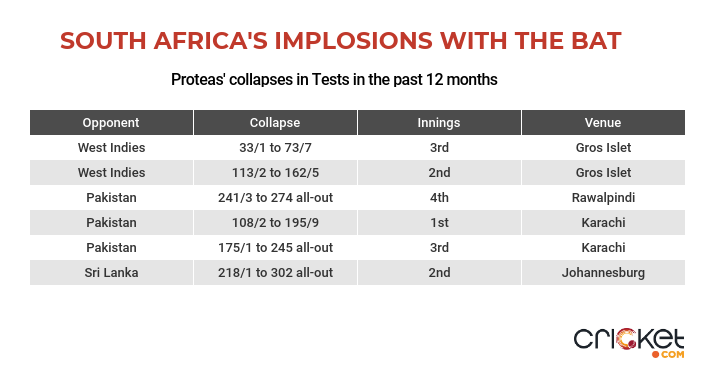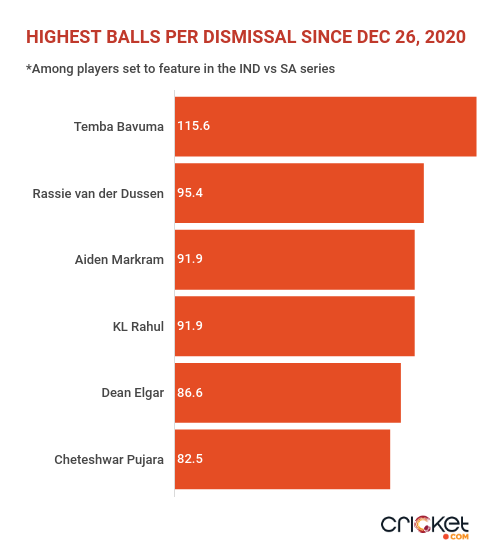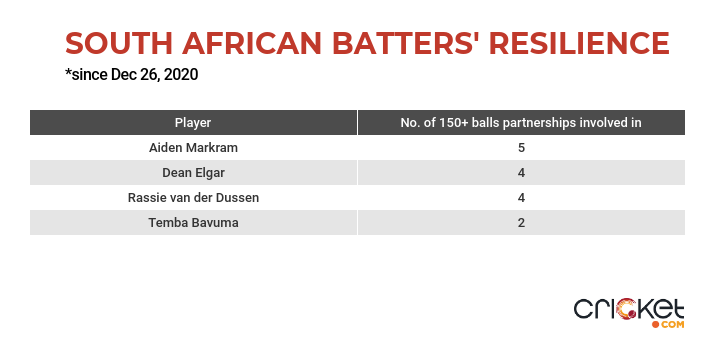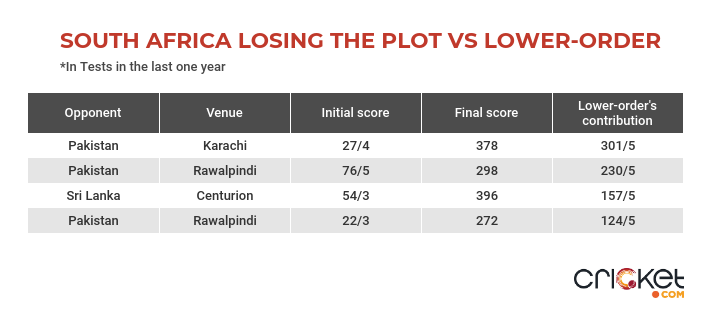News
What can we infer from South Africa’s most recent outings in Test cricket?
 ANALYSIS
ANALYSISTeam India might wanna keep a close eye on some of these points
It’s been nearly four years since India last toured South Africa and a lot has changed since then on the Proteas front. Five of the players who were a part of the playing XI the last time India played a Test in the Rainbow Nation, in Johannesburg in 2018, have retired altogether, and the visitors, this time around, will be up against a very green, different-looking South African unit.
We know South Africa have not won a lot in Tests of late, and we know this is India’s best ever chance to record a series win in the country, but what can the visitors realistically expect from this new-look Proteas unit?
In the six Tests the Proteas have played since the pandemic restart, there have been a few noticeable patterns and threats that Virat Kohli’s side should be aware of.
A collapse is always around the corner
It is no secret that South Africa, much like every other team in the Test landscape these days, possess a fragile batting unit. But of late, in particular, they’ve tended to fall like a pack of cards at some stage in nearly every single Test match, notwithstanding the situation or the complexion of the game.
The Proteas have batted 10 times since the pandemic restart, and quite astonishingly they’ve suffered major collapses, sometimes fatal ones, in six of those innings.

What’s noticeable from the table above is that on vast majority of occasions, the team has really collapsed out of nowhere after evidently being on the front foot. A fourth-innings collapse in the sub-continent is understandable, so is a collapse in the third innings whilst setting a target on the back of a big first innings lead, but there have been instances where this team has imploded on flat batting tracks whilst having the opponent at their mercy.
Head coach Mark Boucher himself admitted this in the aftermath of the Pakistan series. "We just seem to, in big moments, when we really need to drive home an advantage, find ways to get out.”
India themselves effected several such collapses in England four months ago, so this particular pattern should give the visitors plenty of confidence, knowing that they will always be in the contest no matter what the scorecard says.
But there are a few tough nuts to crack in this team too
The previous section laid bare the tendency of this South African batting unit to buckle. But what’s also interesting is, synchronously, this team possesses several gallant individuals who of late have been very tough nuts to crack. The primary reason why the Proteas have, at some stage, found themselves in dominant positions in each of their previous six Tests.
Aiden Markram, Dean Elgar, Rassie van der Dussen and Temba Bavuma constitute the nucleus of the side and all four players have been valorous with the bat in hand, especially when they’ve had their backs to the wall.
Among the batters who will be featuring in the forthcoming series, Bavuma, RVD and Markram take gold, silver and bronze for the best balls-per-dismissal ratio in Tests since Boxing Day last year. In fact, KL Rahul is the only Indian who features in the Top 5.

All these four batters will show resistance, but India will also need to be wary of their tendency to get involved in long partnerships.
Since the pandemic restart, South Africa have had 10 partnerships in Test cricket that have lasted 150 or more deliveries. All but one of those 10 partnerships have featured at least one of the aforementioned four batters. Six of them have seen a combination of these four batters bat together for long periods of time.

So while South Africa might have the tendency to collapse like England did four months ago, they are not a one-man team that consists of multiple passengers. India should expect resistance in plenty.
Watch out for Mulder with the ball
For all the talk of how South Africa might unleash Duanne Olivier in the absence of Nortje, India could end up getting hurt by an unlikely candidate in the form of Wiaan Mulder. The 23-year-old has not done justice to his talent with the bat, yet, but with the ball he’s been sensational, proving to be an extremely potent fourth seam-bowling option.

Mulder bowls the ideal length for South African wickets, and is a master of exploiting seam-friendly conditions. In his short career thus far, he’s averaged 18.38 in conditions that have aided seam bowling (South Africa and West Indies). He is a wobbly customer, and he will test the outside edge of the batters - 85% of his dismissals so far in Test cricket have been caught.
As someone who can double-up as a fourth-seamer that can both serve as a strike bowler and a workhorse, Mulder will keep the Indian batters honest.
Bowlers: Excellent versus the top-order / with the new ball, susceptible to leaking runs vs the lower-order
Of late, South Africa have been blowing teams away with the new ball. Specifically, they’ve been ripping apart the top and middle-order of teams.
Since Boxing Day last year, the Proteas have taken 57 top five (openers to No.5) wickets at a stunning average of 23.3. No other team has come close to matching this record, with the second-best being Pakistan at 29.9.
Anrich Nortje (17 wickets @ 22.5 against Top 5 batters) has had a large part to play in this, no doubt, but every other South African bowler has averaged below 23 against Top 5 batters in this period, with Rabada (11 wickets @ 16.9) being the best of the lot.
This is largely because they’ve been sensational with the new ball, boasting the best average (22.3) among all teams in this period.
In stark contrast, however, the Proteas have been loose in the second part of the innings, dropping the ball versus the lower-order and the tail. Since Boxing Day last year, among the Top 8 teams, only West Indies (24.3) have a worse average against batters No.6 to No.11 than South Africa (23.5).

On three occasions in the past year South Africa allowed the opposition lower-order to add more than 150 runs, with them losing the Pakistan series partially because of their inability to kill teams off. In Rawalpindi, the last five Pakistan batters added 230 runs, while in Karachi the Pakistan lower-order remarkably was allowed to score 301 runs. On both occasions the lapse towards the second half of the innings dearly cost the Proteas.
This, if anything, goes on to prove that lower-order runs could prove to be invaluable for India in the forthcoming series. All the more incentive to pick someone like Shardul Thakur, and maybe even play an extra batter at No.6.